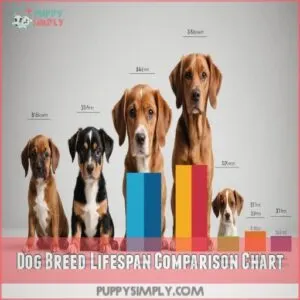This site is supported by our readers. We may earn a commission, at no cost to you, if you purchase through links.
 Pug selective breeding has shaped their charming but health-challenged appearance.
Pug selective breeding has shaped their charming but health-challenged appearance.
Over centuries, breeders prioritized features like flat faces, curled tails, and large, round eyes to meet human preferences.
Unfortunately, this process also created serious health issues.
Their squished noses, while cute, often cause breathing problems, and those iconic wrinkles can trap moisture, leading to skin infections.
It’s like designing a car to look amazing but giving it bad brakes.
While pugs are affectionate companions, their selective breeding raises concerns about prioritizing looks over well-being.
Curious how this all began and what it means for today’s pugs?
Their history tells an interesting story.
Table Of Contents
- Key Takeaways
- What is Pug Selective Breeding?
- History of The Pug Breed
- What Makes The Pug Desirable?
- Are Pugs Selectively Bred?
- Pug Breeding Cruelty
- Today’s Pug
- Frequently Asked Questions (FAQs)
- How Much Do Pugs Typically Cost?
- What Type of Health Issues Are Common Among Pugs?
- Is There a Difference Between Pet Pugs and Show Pugs?
- Do Pugs Require a Lot of Grooming?
- Are There Any Specific Dietary Requirements for Pugs?
- What are the disadvantages of selective breeding pugs?
- Can pugs reproduce on their own?
- How did they make a pug?
- What is the reverse pug breed?
- How much do pugs typically cost?
- Conclusion
Key Takeaways
- Selective breeding for pugs’ cute features like flat faces and curly tails has caused major health problems, including breathing issues and skin infections.
- Pug health struggles stem from limited genetic diversity, with traits like brachycephaly and a lack of functional design prioritized over well-being.
- Responsible breeders focus on health testing and ethical practices to reduce risks, but unethical breeding still causes cruelty and suffering.
- Understanding the breed’s history and health challenges helps you make informed decisions, whether adopting or buying from a reputable breeder.
What is Pug Selective Breeding?
Pug selective breeding is all about shaping these adorable dogs to meet specific breed standards, but it’s not without its ethical concerns. Over centuries, breeders have focused on creating Pugs with desired traits like their wrinkled faces, curled tails, and playful temperament.
Shaping Pugs for cuteness often comes with a hidden cost—health challenges tied to selective breeding practices.
However, this process often comes at a cost to their health. By carefully controlling which dogs mate, breeders aim to enhance predictability in size, color, and personality.
While this sounds ideal, the lack of genetic diversity has led to serious health implications, including respiratory issues and genetic defects. Pugs were originally bred as imperial companions in ancient China, where they were treasured.
Breeding standards today try to balance appearance with health, but it’s a tricky line to walk. Responsible breeders now emphasize ethical practices, selecting parents based on both physical traits and health history.
Still, the legacy of selective breeding reminds us that cuteness can sometimes come with a hidden price.
History of The Pug Breed
You might be surprised to learn that pugs have a long history, starting as royal companions in ancient China.
Over time, their charm spread to Europe, where they became favorites of aristocrats and even symbols of status.
Origins in China
Long before their wrinkled faces charmed the world, these ancient dogs were Imperial Companions in China, cherished by emperors and their families.
They weren’t just pets—they symbolized wealth, power, and prestige. Chinese culture celebrated these small, loyal dogs, often featuring them in Ancient Depictions, from paintings to sculptures.
Their Breed Ancestry traces back to Chinese Mastiffs, with Early Traits like a shorter coat and a less exaggerated snout than modern Pugs.
Selective breeding began here, shaping them into the affectionate, playful companions we recognize today. Their role was never about work; they were bred purely for companionship, spending their days in the laps of royalty.
This ancient breed’s history is a tribute to their enduring charm and the deep bond they formed with humans centuries ago.
Popularity in Europe
Through centuries of selective breeding and cultural symbolism, pugs charmed their way into the hearts of European monarchs, becoming a fixture in royal families.
Their popularity in Europe soared, thanks to their playful nature and distinct features.
Dutch trade played a key role in spreading the breed, with pugs even serving as a symbol for Dutch Prince William the Silent in Freemasonry.
Here’s why pugs captured royal attention:
- Royal Influence: Pugs were lapdogs for kings, queens, and nobility.
- European Depictions: Paintings and sculptures immortalized their wrinkled faces.
- Breed Spread: Dutch merchants introduced them to new regions.
- Cultural Symbolism: A status symbol among aristocrats.
- Selective Breeding: Longer snouts initially improved their health.
Despite their charm, overbreeding later led to health challenges.
What Makes The Pug Desirable?
It’s easy to see why pugs have charmed their way into homes worldwide.
Their cute appearance, with wrinkly faces and big, expressive eyes, feels like something straight out of a children’s storybook.
Add to that their small size, making them a perfect fit for snug apartments, and you’ve got a recipe for canine popularity.
But there’s more—pugs are known for their loyal companionship, often sticking to their humans like glue.
Their playful nature and goofy antics make them delightful to be around.
Historically, their status as favored pets of royalty only adds to their charm.
Selective breeding has emphasized these desirable traits, from their brachycephaly to their breed standards, ensuring they remain irresistible, despite challenges linked to pug health.
Are Pugs Selectively Bred?
It’s surprising how much thought has gone into shaping the modern pug.
Through selective breeding, breeders have modified their genetics to meet strict breed standards. Characteristics like their flat faces, curly tails, and large eyes are all products of generations of intentional breeding—though not without ethical concerns.
These choices have also increased inbreeding risks, magnifying health issues such as brachycephaly, hip dysplasia, and breathing problems. While pugs are undeniably adorable, their genetic modification has come with consequences.
Breeding consequences remind us why health prioritization matters. Choosing ethical breeders who focus on reducing these risks can help guarantee healthier companions while supporting responsible pug selective breeding practices for future generations.
Pug Breeding Cruelty
Pug selective breeding has led to heartbreaking consequences for these lovable dogs.
Heartbreaking consequences from pug selective breeding highlight the hidden costs of shaping cuteness at the expense of their health.
Puppy mills prioritize profit over health, perpetuating cruel breeding practices that worsen genetic defects.
Breeding deformities, like flat faces and tightly curled tails, are celebrated despite causing severe pug health issues, including breathing difficulties and hip dysplasia.
These unethical standards often result in animal cruelty, as dogs endure lifelong discomfort.
Understanding the impact of pug cruelty is vital for potential owners.
Consumer awareness is key—choosing reputable breeders who prioritize health over aesthetics can help combat these practices and guarantee happier, healthier Pugs.
Today’s Pug
Today’s Pugs remain a favorite worldwide, charming owners with their playful and affectionate nature.
However, modern Pug health is a growing concern due to selective breeding for exaggerated traits like their wrinkled faces and brachycephalic snouts.
Responsible breeders now prioritize health over appearance, adhering to strict breed standards to reduce respiratory issues and other health problems.
If you’re considering Pug ownership, here are four things to keep in mind:
- Health Testing: Reputable breeders perform tests like elbow x-rays to guarantee healthier litters.
- Weight Management: Overweight Pugs face added risks, so maintaining a healthy weight is essential.
- Daily Care: Regular cleaning of facial wrinkles and a quality diet are non-negotiable.
- Exercise Needs: While not overly active, Pugs still need moderate exercise to avoid obesity.
With proper care and ethical breeding, these lovable companions can thrive, but their future depends on informed choices.
Frequently Asked Questions (FAQs)
How Much Do Pugs Typically Cost?
You can expect to pay anywhere from $600 to $2,500 for a Pug, depending on factors like breeder reputation, pedigree, and location.
Adopting from shelters or rescues often costs less while providing a loving home.
What Type of Health Issues Are Common Among Pugs?
You’ll often find pugs struggling with breathing problems, skin infections, and eye issues, all tied to their facial structure.
Other concerns include obesity, hip problems, and a higher risk of expensive veterinary care.
Is There a Difference Between Pet Pugs and Show Pugs?
Show pugs are bred to meet strict standards, focusing on appearance, like perfect wrinkles and tails, while pet pugs prioritize companionship and personality.
Show types may face stricter breeding, often leading to health complications.
Do Pugs Require a Lot of Grooming?
Pugs don’t need heavy grooming, but their wrinkles require consistent cleaning to prevent infections.
Brush their coat weekly to manage shedding, and don’t skip nail trims or ear checks—they’re essential for a happy, healthy pup!
Are There Any Specific Dietary Requirements for Pugs?
Balanced bites bring benefits!
Feed your pug high-quality, easily digestible food rich in protein and low in fillers.
Watch portions carefully—they’re prone to porkiness.
Add omega-3s for their coat and limit treats to avoid extra pounds!
What are the disadvantages of selective breeding pugs?
Selective breeding creates health problems like breathing issues, hip dysplasia, and eye concerns.
It prioritizes looks over health, leading to discomfort and shorter lifespans.
Responsible breeding could reduce these issues, improving both health and happiness.
Can pugs reproduce on their own?
You might think all dogs can naturally reproduce, but pugs often struggle due to their body structure.
Their narrow hips and compact build can make mating difficult, leading many breeders to rely on artificial insemination.
How did they make a pug?
Breeders shaped the pug over centuries, starting in ancient China, to create a compact, flat-faced companion.
Through selective breeding for specific features like wrinkled faces and curly tails, they crafted today’s adorable but health-challenged pups.
What is the reverse pug breed?
The reverse pug, or "retro pug," is a healthier crossbreed often achieved by mixing a pug with a Jack Russell or beagle.
This pairing helps reduce health issues while keeping the pug’s playful charm.
How much do pugs typically cost?
Imagine handing over a small fortune for a furry bundle of joy—a pug typically costs $800-$2,
Prices vary by pedigree, breeder reputation, and location, so be ready to spend more for show-quality pups!
Conclusion
Strangely enough, the love for pugs’ adorable features has also been their greatest challenge.
Pug selective breeding may have crafted their signature flat faces and big eyes, but it’s also left them grappling with breathing troubles, skin issues, and more.
As you consider these lovable companions, it’s necessary to understand the impact of breeding choices on their health.
By supporting responsible breeders or even adoption, you can help guarantee a healthier, happier future for pugs.











